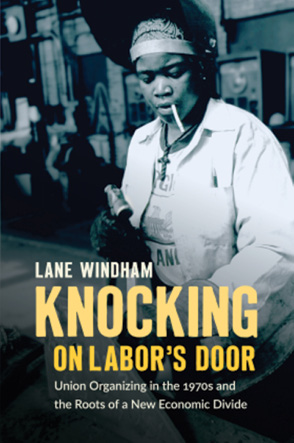Public Employee Press
A fresh look at labor organizing in the 1970s
 In her new book “Knocking on Labor’s Door: Union Organizing in the 1970’s and the Roots of a New Economic Divide,” Lane Windham recounts the untold story of the upsurge of labor organizing in the 1970s which was especially led by youth, people of color and women who were inspired by the victories of the civil rights movement.
In her new book “Knocking on Labor’s Door: Union Organizing in the 1970’s and the Roots of a New Economic Divide,” Lane Windham recounts the untold story of the upsurge of labor organizing in the 1970s which was especially led by youth, people of color and women who were inspired by the victories of the civil rights movement.
Much recent scholarship shifts blame for labor’s decline to unions and the working class by asserting that private-sector workers were simply no longer trying to organize by the mid-1970s.
Windham documents that this was a period of labor upsurge in organizing that built on past movement advances in worker consciousness and real legislative and legal victories.
In union organizing, many of the workers who came knocking on unions’ doors were the women and people of color who had long been excluded from the nation’s best jobs and from some unions.
These wokers had recently gained new access through Title VII of the 1964 Civil Rights Act.
The 70s were also a period of rank and file activism and revolt inside established unions in terms of strike activity and challenges to established leadership Windham breaks new ground with a her dramatic case studies of worker victories in an organizing wave of half a million workers a year that aimed to form unions in the private sector.
In union organizing, many of the workers who came knocking on unions’ doors were the women and people of color who had long been excluded from the nation’s best jobs and from some unions.
She focuses on five dramatic case studies of mostly Southern worker victories: the largest union election ever in the South which was at Newport News; Virginia shipyard workers in 1978; campaigns in 1974 and 1985 by Cannon Mills textile workers in Kannapolis, N.C.; the 1979 campaign to organize workers at Woodward & Lothrop in Washington, D.C.; and the women office workers’ group 9to5 in Boston that forged a new kind of labor organizing simultaneously on the community and labor fronts.
Despite these victories, union organizing was an uphill battle with success becoming less frequent in the 1970s.
Running parallel and counter to this worker activism, business attacks on unions accelerated, using coordinated legal maneuvers to manipulate weak labor laws to derail organizing campaigns.
Corporate profits and CEO salaries skyrocketed nationwide while pay, benefits, and working conditions stagnated or declined for most everyone else.
Unions, once the main institutions of working-class power, became a shadow of their former selves and are now struggling to stop their decline at the hands of both relentless corporate attacks and internal decay, especially as attacks intensified in the Reagan years.
Recounting how employees attempted to unionize against overwhelming odds, “Knocking on Labor’s Door” dramatically refashions the narrative of working-class struggle during a crucial decade and shakes up current debates about labor’s
future.
Ken Nash is a retired librarian of the DC 37 Education Fund Library, and co-host of WBAI Radio’s Building Bridges.


